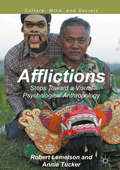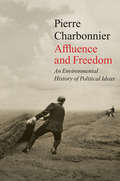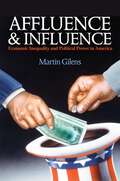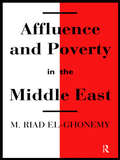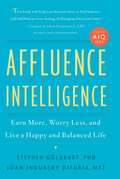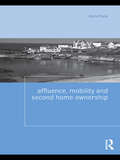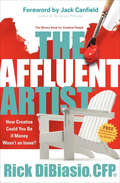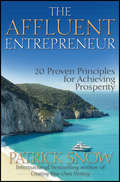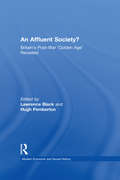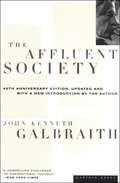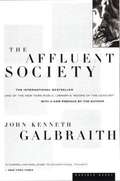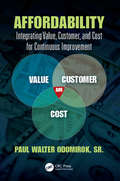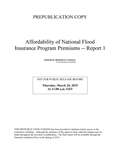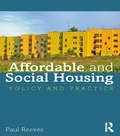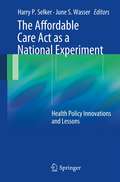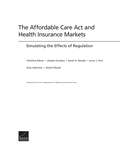- Table View
- List View
Affliction (The Withered Series #3)
by Amy MilesA woman on the verge of becoming a flesh-eating zombie fights to save the lives of others in this post-apocalyptic, science fiction horror novel.Though Avery Whitlock may have won the battle of the Grand Opry hotel, she knows the war is just beginning. Cable would stop at nothing to have her now that she was within his grasp—but to stay meant endangering innocent lives. No longer fully human and unwilling to accept her fate as a flesh-eating zombie, she must abandon the only place she could call home in order to save Nox and his people.Driven to prevent anyone else from suffering from the same fate, she follows the trail of the doctor responsible for the heinous mutations as he races to reach the Atlanta Safe Zone. But with spilled blood on her hands and malice in her heart, her cravings to kill become amplified—and her grip on her humanity begins to slip.Only the love of those closest to Avery can bring her back from the edge, but will they be able to reach her in time to save their own lives?
Afflictions: Steps Toward a Visual Psychological Anthropology (Culture, Mind, and Society)
by Annie Tucker Robert LemelsonThis book is one of the first to integrate psychological and medical anthropology with the methodologies of visual anthropology, specifically ethnographic film. It discusses and complements the work presented in Afflictions: Culture and Mental Illness in Indonesia, the first film series on psychiatric disorders in the developing world, in order to explore pertinent issues in the cross-cultural study of mental illness and advocate for the unique role film can play both in the discipline and in participants' lives. Through ethnographically rich and self-reflexive discussions of the films, their production, and their impact, the book at once provides theoretical and practical guidance, encouragement, and caveats for students and others who may want to make such films.
Affluence and Freedom: An Environmental History of Political Ideas
by Pierre CharbonnierIn this pathbreaking book, Pierre Charbonnier opens up a new intellectual terrain: an environmental history of political ideas. His aim is not to locate the seeds of ecological thought in the history of political ideas as others have done, but rather to show that all political ideas, whether or not they endorse ecological ideals, are informed by a certain conception of our relationship to the Earth and to our environment. The fundamental political categories of modernity were founded on the idea that we could improve on nature, that we could exert a decisive victory over its excesses and claim unlimited access to earthly resources. In this way, modern thinkers imagined a political society of free individuals, equal and prosperous, alongside the development of industry geared towards progress and liberated from the Earth’s shackles. Yet this pact between democracy and growth has now been called into question by climate change and the environmental crisis. It is therefore our duty today to rethink political emancipation, bearing in mind that this can no longer draw on the prospect of infinite growth promised by industrial capitalism. Ecology must draw on the power harnessed by nineteenth-century socialism to respond to the massive impact of industrialization, but it must also rethink the imperative to offer protection to society by taking account of the solidarity of social groups and their conditions in a world transformed by climate change. This timely and original work of social and political theory will be of interest to a wide readership in politics, sociology, environmental studies and the social sciences and humanities generally.
Affluence and Influence: Economic Inequality and Political Power in America
by Martin GilensWhy policymaking in the United States privileges the rich over the poorCan a country be a democracy if its government only responds to the preferences of the rich? In an ideal democracy, all citizens should have equal influence on government policy—but as this book demonstrates, America's policymakers respond almost exclusively to the preferences of the economically advantaged. Affluence and Influence definitively explores how political inequality in the United States has evolved over the last several decades and how this growing disparity has been shaped by interest groups, parties, and elections.With sharp analysis and an impressive range of data, Martin Gilens looks at thousands of proposed policy changes, and the degree of support for each among poor, middle-class, and affluent Americans. His findings are staggering: when preferences of low- or middle-income Americans diverge from those of the affluent, there is virtually no relationship between policy outcomes and the desires of less advantaged groups. In contrast, affluent Americans' preferences exhibit a substantial relationship with policy outcomes whether their preferences are shared by lower-income groups or not. Gilens shows that representational inequality is spread widely across different policy domains and time periods. Yet Gilens also shows that under specific circumstances the preferences of the middle class and, to a lesser extent, the poor, do seem to matter. In particular, impending elections—especially presidential elections—and an even partisan division in Congress mitigate representational inequality and boost responsiveness to the preferences of the broader public.At a time when economic and political inequality in the United States only continues to rise, Affluence and Influence raises important questions about whether American democracy is truly responding to the needs of all its citizens.
Affluence and Poverty in the Middle East
by M. Riad El-GhonemyAffluence and Poverty in the Middle East is an introduction to the political economy of the Middle East, focusing on its most salient features - persistent poverty and extreme inequality. El-Ghonemy analyses the factors influencing the region, including its unique historical, religious and cultural mix, as well as its economic foundations and forms of corruption. For each factor he employs case-studies drawn from throughout the region, from Turkey to Sudan and Morocco to Iran. In the final section El-Ghomeny discusses possible solutions to the challenges facing the region, including possible uses of a peace dividend, and the role of democracy.
Affluence, Austerity and Electoral Change in Britain
by Paul Whiteley Harold D. Clarke David Sanders Marianne C. Stewart Paul Whiteley Harold D. Clarke David SandersAffluence, Austerity and Electoral Change in Britain investigates the political economy of party support for British political parties since Tony Blair led New Labour to power in 1997. Using valence politics models of electoral choice and marshalling an unprecedented wealth of survey data collected in the British Election Study's monthly Continuous Monitoring Surveys, the authors trace forces affecting support for New Labour during its thirteen years in office. They then study how the recessionary economy has influenced the dynamics of party support since the Conservative-Liberal Democrat Coalition came to power in May 2010 and factors that shaped voting in Britain's May 2011 national referendum on changing the electoral system. Placing Britain in comparative perspective with cross-national survey data gathered in the midst of the worst recession since the 1930s, the authors investigate how the economic crisis has affected support for incumbent governments and democratic politics in over twenty European countries.
Affluence Intelligence: Earn More, Worry Less, and Live a Happy and Balanced Life
by Stephen Goldbart Joan DifuriaWe have just come through the worst recession many of us have ever seen, and in times like these, it's tempting to think that just having more money would solve our problems. Indeed, it is also widely believed that how wealthy you are is a result of external factors, such as job promotions or good investments. But the surprising truth is that affluence is actually based on a certain way of thinking, one which has never before been discussed. Now, after years of working with clients of all backgrounds--including billionaires--psychologists Stephen Goldbart and Joan DiFuria reveal the little-known concept of "Affluence Intelligence," a mindset that makes people not just wealthy but deeply fulfilled. The book includes a test to determine your Affluence Intelligence Quotient (AIQ), and a step-by-step program to raise that AIQ in just three months, for more money, more security, and more joy. Affluence Intelligence is for everyone who suspects they are devoting too much time to worrying about finances and too little time to living life.
Affluence, Mobility and Second Home Ownership (Housing and Society Series)
by Chris ParisDespite the current recession, the frequency of second home ownership is still surprisingly high throughout the western world. While the UK and Ireland previously had lower occurrences of multiple dwellings compared to the rest of Europe, they are quickly catching up with a current surge in the ownership of second homes. The recent MP expenses scandal in the UK has also drawn attention to the prevalence of second homes (or more) within the middle classes, and the fact that the concept is becoming increasingly popular. Chris Paris uses this text to address the reasons behind why second homes are becoming more popular, both within the usual domicile of the individuals, and in international locations. The socioeconomic factors and historical contexts of homes in cultures across the world are fundamental to explaining the choices in transnational home ownership, and Paris’ case studies and comparisons between additional homes in Europe, Australia, America and Asia expand upon the motivation for people to own a second home. Affluence, Mobility and Second Home Ownership draws together debates on gentrification, globalisation, consumerism, environmental factors and investment to provide a balanced look at the pros, and cons, of second home ownership, and what implications it has for the future. An ideal text for students studying geography, urbanism and planning, this book is also of interest to individuals interested in the changing ways in which we make choices on our places of residence.
The Affluent Artist: The Money Book for Creative People: How Creative Could You Be If Money Wasn't an Issue?
by Rick DiBiasio&“A &‘must read&’ for the creative person who wants to implement their creative power to obtain lasting financial abundance, freedom and independence&” (Linda Mackenzie, founder, HealthyLife.net-All Positive Talk Radio). The Affluent Artist invites artists from all walks of life to throw out the stereotypes about art and money and allow financial abundance into their lives. Whether you&’ve been learning to train dolphins for SeaWorld, working as a Broadway dancer or as an Imagineer for Disney, chances are you&’ve been learning about the craft, not about personal finance. This book offers business and financial planning wisdom to creative individuals who find themselves in the roles of the Starving Artist, the Corporate Artist, the Self Employed Artist and the Affluent Artist. The book includes stories and interviews with artists in each of these roles as well as Financial Stuff You Just Gotta Know, a humorous and necessary primer on financial terms and situations, as well as a how-to on avoiding financial pitfalls, and a business fable based on Rick DiBiasio&’s years of experience helping artists find their financial footing. &“Most people don&’t believe they can live their passion and make a lot of money at the same time. Not only does Rick&’s book debunk that myth, he teaches you HOW to do it. If you want to make a lot of money doing what you love to do, GET THIS BOOK and read it cover to cover so you can LIVE YOUR LIFE OUT LOUD.&” —Sean Smith, Master Results coach
The Affluent Entrepreneur
by Patrick SnowTake charge of your financial future and improve your overall well beingIn today's unpredictable economy, the best way to ensure financial security is to build your own business. You can neither count on nor control your employer's success, but you can depend on your own creativity and solid work ethic to achieve prosperity.The Affluent Entrepreneur empowers you to identify your innermost marketable passion, and then turn that passion into your profession by becoming a successful business, regardless of your background, experience, or level of education.Provides you with 20 proven principles to achieve success faster than you ever imaginedPropels existing entrepreneurs toward reaching the next level with their businessOffers proven advice from an author who has been featured in major newspapers such as USA TODAY, The New York Times, the Denver Post, and the Chicago Sun-Times, as well as on hundreds of radio stationsIf you're tired of depending on others for your success and well being, The Affluent Entrepreneur gives you the edge you need to launch and grow your own business and create your own long-term financial freedom and security.
An Affluent Society?: Britain's Post-War 'Golden Age' Revisited (Modern Economic and Social History)
by Lawrence Black Hugh PembertonDuring an election speech in 1957 the Prime Minister, Harold Macmillan, famously remarked that 'most of our people have never had it so good'. Although taken out of context, this phrase soon came to epitomize the sense of increased affluence and social progress that was prevalent in Britain during the 1950s and 1960s. Yet, despite the recognition that Britain had moved away from an era of rationing and scarcity, to a new age of choice and plenty, there was simultaneously a parallel feeling that the nation was in decline and being economically outstripped by its international competitors. Whilst the study of Britain's postwar history is a well-trodden path, and the paradox of absolute growth versus relative decline much debated, it is here approached in a fresh and rewarding way. Rather than highlighting economic and industrial 'decline', this volume emphasizes the tremendous impact of rising affluence and consumerism on British society. It explores various expressions of affluence: new consumer goods; shifting social and cultural values; changes in popular expectations of policy; shifting popular political behaviour; changing attitudes of politicians towards the electorate; and the representation of affluence in popular culture and advertising. By focusing on the widespread cultural consequences of increasing levels of consumerism, emphasizing growth over decline and recognizing the rising standards of living enjoyed by most Britons, a new and intriguing window is opened on the complexities of this 'golden age'. Contrasting growing consumer expectations and demands against the anxieties of politicians and economists, this book offers all students of the period a new perspective from which to view post-imperial Britain and to question many conventional historical assumptions.
The Affluent Society: The Affluent Society And Other Writings, 1952-1967 - American Capitalism; The Great Crash, 1929; The Affluent Society; The New Industrial State (Penguin Economics Ser.)
by John Kenneth GalbraithThe classic by the renowned economist: &“One of those rare works that forces a nation to re-examine its values&” (The New York Times). One of the New York Public Library&’s &“Books of the Century&” Hailed as a &“masterpiece&” (St. Louis Post-Dispatch), this examination of the &“economics of abundance&” cuts to the heart of what economic security means (and doesn&’t mean) and lays bare the hazards of individual and societal complacence about economic inequity. The book that introduced the phrase &“conventional wisdom&” to our vernacular, The Affluent Society is as timely today as when it was first published. &“Warrants careful reading by every thoughtful person.&” —The Christian Science Monitor
The Affluent Society (Fortieth Anniversary Edition)
by John Kenneth GalbraithGalbraith's classic on the "economics of abundance" is, in the words of the New York Times, "a compelling challenge to conventional thought." With customary clarity, eloquence, and humor, Galbraith cuts to the heart of what economic security means (and doesn't mean) in today's world and lays bare the hazards of individual and societal complacence about economic inequity. While "affluent society" and "conventional wisdom" (first used in this book) have entered the vernacular, the message of the book has not been so widely embraced -- reason enough to rediscover The Affluent Society.
Affluenza: The All-Consuming Epidemic
by John De Graaf David Wann Thomas H. NaylorAffluenza uses the metaphor of a disease to tackle a very serious subject: the damage done- to our health, our families, our communities, and our environment-by the obsessive quest for material gain. The author's show that problems like loneliness, rising debt, longer working hours, environmental pollution, family conflict and rampant commercialism are actually symptoms caused by the same "disease" affluenza.
Affluenza: How Overconsumption Is Killing Us—and How to Fight Back
by John De Graaf David Wann Thomas H. NaylorNEW EDITION, REVISED AND UPDATED affluenza, n. a painful, contagious, socially transmitted condition of overload, debt, anxiety, and waste resulting from the dogged pursuit of more. We tried to warn you! The 2008 economic collapse proved how resilient and dangerous affluenza can be. Now in its third edition, this book can safely be called prophetic in showing how problems ranging from loneliness, endless working hours, and family conflict to rising debt, environmental pollution, and rampant commercialism are all symptoms of this global plague. The new edition traces the role overconsumption played in the Great Recession, discusses new ways to measure social health and success (such as the Gross Domestic Happiness index), and offers policy recommendations to make our society more simplicity-friendly. The underlying message isn't to stop buying--it's to remember, always, that the best things in life aren't things.
Affluenza
by James ShermanComedy / 4m, 2f / Interior / A hilarious new play from James Sherman, AFFLUENZA! borrows classic characters from Restoration Comedy like the cuckolded husband, the coquette, the wily servant, and the fop to create a contemporary comedy of manners. When multi-millionaire William Moore brings home his new girlfriend, his son and ex-wife are threatened by the potential new heir to the family fortune. Who gets what and who ends up with whom is revealed in this dazzling display of wit and wordplay. / "James Sherman has created a Moliere play for our times. A clever and delightful piece of theatre." -Chicago Reader
Affordability: Integrating Value, Customer, and Cost for Continuous Improvement (Continuous Improvement Series)
by Paul Walter Odomirok, Sr.Affordability is a new concept that allows the implementation of Continuous Improvement for any organization. It encapsulates contemporary methods that improve product and service profitability, increases market share, value, speed, quality and capability, and cuts down on cost. This new method addresses the needs of growing, improving, and sustaining an organization. It provides a framework and foundation for launching improvement initiatives, deploying continuous improvement, and maintaining the cultural habits and behaviors required to continue such efforts. Case studies from a variety of industries, businesses, and institutions are provided.
Affordability of National Flood Insurance Program Premiums: Report 1
by Committee on the Affordability of National Flood Insurance Program PremiumsThe National Flood Insurance Program (NFIP) is housed within the Federal Emergency Management Agency (FEMA) and offers insurance policies that are marketed and sold through private insurers, but with the risks borne by the U. S. federal government. NFIP's primary goals are to ensure affordable insurance premiums, secure widespread community participation in the program, and earn premium and fee income that covers claims paid and program expenses over time. In July 2012, the U. S. Congress passed the Biggert-Waters Flood Insurance Reform and Modernization Act (Biggert-Waters 2012), designed to move toward an insurance program with NFIP risk-based premiums that better reflected expected losses from floods at insured properties. This eliminated policies priced at what the NFIP called "pre-FIRM subsidized" and "grandfathered. " As Biggert-Waters 2012 went into effect, constituents from multiple communities expressed concerns about the elimination of lower rate classes, arguing that it created a financial burden on policy holders. In response to these concerns Congress passed The Homeowner Flood Insurance Affordability Act of 2014 (HFIAA 2014). The 2014 legislation changed the process by which pre-FIRM subsidized premiums for primary residences would be removed and reinstated grandfathering. As part of that legislation, FEMA must report back to Congress with a draft affordability framework. "Affordability of National Flood Insurance Program Premiums: Report 1" is the first part of a two-part study to provide input as FEMA prepares their draft affordability framework. This report discusses the underlying definitions and methods for an affordability framework and the affordability concept and applications. "Affordability of National Flood Insurance Program Premiums" gives an overview of the demand for insurance and the history of the NFIP premium setting. The report then describes alternatives for determining when the premium increases resulting from Biggert-Waters 2012 would make flood insurance unaffordable.
Affordability of National Flood Insurance Program Premiums: Report 2
by National Academies of Sciences, Engineering, and Medicine Committee on the Affordability of National Flood Insurance Program Premiums Water Science and Technology Board Division on Earth and Life Studies Board on Mathematical Sciences And Their Applications Division on Engineering and Physical Sciences Committee on National Statistics Division of Behavioral and Social Sciences and EducationWhen Congress authorized the National Flood Insurance Program (NFIP) in 1968, it intended for the program to encourage community initiatives in flood risk management, charge insurance premiums consistent with actuarial pricing principles, and encourage the purchase of flood insurance by owners of flood prone properties, in part, by offering affordable premiums. The NFIP has been reauthorized many times since 1968, most recently with the Biggert-Waters Flood Insurance Reform Act of 2012 (BW 2012). In this most recent reauthorization, Congress placed a particular emphasis on setting flood insurance premiums following actuarial pricing principles, which was motivated by a desire to ensure future revenues were adequate to pay claims and administrative expenses. BW 2012 was designed to move the NFIP towards risk-based premiums for all flood insurance policies. The result was to be increased premiums for some policyholders that had been paying less than NFIP risk-based premiums and to possibly increase premiums for all policyholders. Recognition of this possibility and concern for the affordability of flood insurance is reflected in sections of the Homeowner Flood Insurance Affordability Act of 2014 (HFIAA 2014). These sections called on FEMA to propose a draft affordability framework for the NFIP after completing an analysis of the efforts of possible programs for offering “means-tested assistance” to policyholders for whom higher rates may not be affordable. BW 2012 and HFIAA 2014 mandated that FEMA conduct a study, in cooperation with the National Academies of Sciences, Engineering, and Medicine, which would compare the costs of a program of risk-based rates and means-tested assistance to the current system of subsidized flood insurance rates and federally funded disaster relief for people without coverage. Production of two reports was agreed upon to fulfill this mandate. This second report proposes alternative approaches for a national evaluation of affordability program policy options and includes lessons for the design of a national study from a proof-of-concept pilot study.
Affordability of National Flood Insurance Program Premiums: Report 2
by National Academies of Sciences Engineering MedicineWhen Congress authorized the National Flood Insurance Program (NFIP) in 1968, it intended for the program to encourage community initiatives in flood risk management, charge insurance premiums consistent with actuarial pricing principles, and encourage the purchase of flood insurance by owners of flood prone properties, in part, by offering affordable premiums. The NFIP has been reauthorized many times since 1968, most recently with the Biggert-Waters Flood Insurance Reform Act of 2012 (BW 2012). In this most recent reauthorization, Congress placed a particular emphasis on setting flood insurance premiums following actuarial pricing principles, which was motivated by a desire to ensure future revenues were adequate to pay claims and administrative expenses. BW 2012 was designed to move the NFIP towards risk-based premiums for all flood insurance policies. The result was to be increased premiums for some policyholders that had been paying less than NFIP risk-based premiums and to possibly increase premiums for all policyholders. Recognition of this possibility and concern for the affordability of flood insurance is reflected in sections of the Homeowner Flood Insurance Affordability Act of 2014 (HFIAA 2014). These sections called on FEMA to propose a draft affordability framework for the NFIP after completing an analysis of the efforts of possible programs for offering “means-tested assistance” to policyholders for whom higher rates may not be affordable. BW 2012 and HFIAA 2014 mandated that FEMA conduct a study, in cooperation with the National Academies of Sciences, Engineering, and Medicine, which would compare the costs of a program of risk-based rates and means-tested assistance to the current system of subsidized flood insurance rates and federally funded disaster relief for people without coverage. Production of two reports was agreed upon to fulfill this mandate. This second report proposes alternative approaches for a national evaluation of affordability program policy options and includes lessons for the design of a national study from a proof-of-concept pilot study.
Affordable and Social Housing: Policy and Practice
by Paul ReevesAffordable and Social Housing - Policy and Practice is a candid and critical appraisal of current big-ticket issues affecting the planning, development and management of affordable and social housing in the United Kingdom. The successor to the second edition of the established textbook An Introduction to Social Housing, the book includes new chapters, reflecting the focal importance of customer involvement and empowerment, regeneration and the Localism agenda which will have radical impacts on housing provision and tenure, as well as the town and country planning system which enables its development. There is also a new chapter on Housing Law in response to demand for a clear and signposting exposition of this often complex area. Reeves indicates how each theme affects the other, and suggests policy directions on the basis of past successes and failures. Paul Reeves takes a people-centred approach to the subject, describing the themes that have run through provision of social housing from the first philanthropic industrialists in the 19th Century though to the increasingly complex mixture of ownerships and tenures in the present day. The book is ideal for students of housing and social policy, and for housing professionals aiming to obtain qualifications and wanting a broad understanding of the social housing sector.
The Affordable Care Act: A National Experiment
by June Wasser Harry SelkerThis book examines the landmark 2010 Patient Protection and Affordable Care Act (ACA) from the perspective of health policy research as translational science. It delineates a new perspective about the creation and potential impact of the ACA and guides the development of health policy that is supported by best evidence that, in turn, transforms into practice, policy, and public benefit. Told by those involved in the creation and implementation of the ACA, the book reviews the history and impact of this ground-breaking legislation and recommends priorities, objectives, and next steps for translational research as the ACA is implemented. The book includes coverage of these topics: · Objectives of the ACA · Analysis of data collected from healthcare reform programs in Vermont and Massachusetts to inform national implementation of the ACA · Engaging the public in, and building support for, ACA implementation · Interplay of federal, state, and local healthcare policy decisions arising from the enforcement of the ACA Featuring contributions from nationally renowned leaders in healthcare policy, this book adds to the public conversation about the ACA and its role in shaping health policy and contributes to a more realistic, nuanced, and productive understanding of this landmark legislation by physicians, policy makers, and the public. It also provides a framework for next steps in continuing to improve U.S. health policy.
The Affordable Care Act (A): Legislative Strategy in the House of Representatives
by Michael Norris Joseph L. BowerIn early 2009, the Obama administration and the Democratically-led Congress began working on what would eventually become the Affordable Care Act. The (A) case in this series discusses the legislative strategy in the House of Representatives, where three different committees each had jurisdiction over health care legislation.
The Affordable Care Act (A): Legislative Strategy in the House of Representatives
by Joseph L. Bower Michael NorrisIn early 2009, the Obama administration and the Democratically-led Congress began working on what would eventually become the Affordable Care Act. The (A) case in this series discusses the legislative strategy in the House of Representatives, where three different committees each had jurisdiction over health care legislation.
The Affordable Care Act and Health Insurance Markets: Simulating the Effects of Regulation
by Christine Eibner Amado Cordova Sarah A. Nowak Carter C. Price Evan Saltzman Dulani WoodsIn this report, the authors estimate the effects of the Affordable Care Act on health insurance enrollment and premiums for ten states (Florida, Kansas, Louisiana, Minnesota, New Mexico, North Dakota, Ohio, Pennsylvania, South Carolina, and Texas) and for the nation overall, with a focus on outcomes in the nongroup and small group markets.

